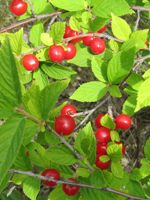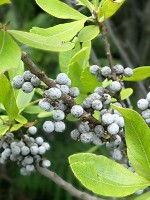Mon-Fri 9am - 5pm Mountain time
Nanking Cherry vs Northern Bayberry
Prunus tomentosa
Myrica pensylvanica
NOT AVAILABLE THIS SEASON - MIGHT RETURN
Nanking Cherry is a small deciduous shrub known for its attractive white blossoms and edible fruit. Its dark red berries are excellent for pies, jellies, and even fresh eating.
Nanking Cherry is highly regarded as a shade tolerant fruit. We often see it planted as a hedge on the north side of a house where few other plants will survive, let alone thrive.
Expect fruit mid to late July. The fruit can vary in sweetness and size considerably. We often hear that people prefer it to sour cherries. Perhaps this is because Nanking Cherry is more closely related to plums. In fact, it is sometimes used as a dwarfing rootstock for plums.
Northern Bayberry makes an excellent hedge or feature shrub. It will retain its leaves in warmer climates but drops them in colder areas. They produce blue-grey berries that have a wax coating on them that can be used to make candles or soaps.
In colder hardiness zones the leaves turn an attractive orange to red colour in the fall, making it a striking addition to your landscape.
Northern Bayberry is native to Nova Scotia and tolerates both drought and wet conditions. It is also a nitrogen fixer that tolerates poor soil conditions.
Nanking Cherry Quick Facts
Northern Bayberry Quick Facts
Toxicity: Warning: The wax from bayberry fruit is considered toxic and may be carcinogenic.

